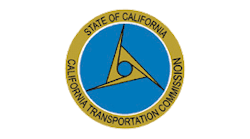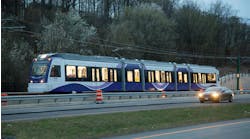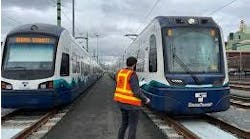Caltrain to pilot first battery-equipped electric multiple unit train
The California Transportation Commission (CTC) approved the allocation of funds from a California State Transportation Agency (CalSTA) $80 million award for one battery-equipped electric multiple unit train (BEMU) and the associated research and development. The approval to use the grant will allow Caltrain to be operable with zero-emission trains on both the electrified service area of the corridor, as well as the portion of the corridor from Tamien Station in San Jose to Gilroy that does not yet have overhead electrified lines.
The BEMU train, which will be purchased on a contract option with Stadler, Caltrain’s electric train manufacturer, is an electric multiple unit (EMU) train with additional energy storage capacity. The BEMU will charge while the train runs on overhead power in the electrified service areas and then use battery charge to travel “off-wire” on non-electrified track areas, leading the way for Caltrain to operate a fully zero-emission service in the future. Before this option, Caltrain notes it would have had to use diesel trains on the non-electrified corridor. The funding award from CalSTA also covers the cost of testing at the Transportation Test Center in Pueblo, Colo., and upgrades to the San Jose Central Maintenance Facility and Gilroy layover and station area to facilitate charging and maintenance.
Caltrain’s contract with Stadler calls for four EMU trains that will replace aging diesel trains. The EMU trains, along with the BEMU demonstration, will allow Caltrain to run more than 90 percent of its service with electric trains, benefiting riders and communities throughout the corridor.
“Stadler is proud to continue our partnership with Caltrain and our shared mission of helping California provide zero-emission travel” said Martin Ritter, CEO of Stadler, U.S. “With additional bi-level EMUs and this first-of-its-kind BEMU for Caltrain, Stadler is able to expand our overall portfolio for the U.S. market, especially in the zero-emission product line.”
The demonstration of the BEMU in-service will be the first time the bi-level technology is in operation on a commuter train anywhere in the United States. The trainset is also expected to be tested in other intercity and regional rail corridors if feasible. The technology could make the transition to electrified service easier for other operators by not requiring full overhead line coverage throughout entire train corridors.
“California continues to lead the transition to a clean, electrified transportation system, this time with the nation’s first battery-electric multiple unit passenger rail train,” said California Transportation Secretary Toks Omishakin. “This efficient, state-of-the-art train – made possible by an award through our Transit and Intercity Rail Capital Program – will lead to improved service for riders and cleaner air between San Francisco and Gilroy, as well as serve as a demonstration train for expanded battery-electric intercity rail service in the future.”
“Today’s unanimous CTC vote was electrifying both figurately and literally as we fund improvements to a corridor that continues to lead the way to improve the lives for thousands of daily commuters and to show the way for other transit systems throughout the country,” said CTC Vice Chair Carl Guardino.
The current demonstration plan will have the BEMU charge while in operations between San Francisco and San Jose and then operate using battery power on non-electrified tracks between San Jose and Gilroy, with intermittent demonstration trips to Salinas. Caltrain says the goal is to show successful service operations and learn from the implementation to provide a roadmap for future BEMU operations and procurements.
If successful, BEMUs could replace aging diesel locomotives on non-electrified tracks. The agency notes the benefits would not only be a reduction in greenhouse gas emissions and improved air quality, but also significant service upgrades, including potential improved service times to Gilroy resulting from better performance of the BEMU compared to diesel locomotives, improved travel times on the entire corridor and decreased service costs resulting from removing diesel locomotives from service and increased reliability should overhead power systems fail or utilities experience outages.
“Silicon Valley has a reputation for first of its kind innovations and our transportation sector is no different,” said Mayor of San Jose Matt Mahan. “This project will pave the way for Caltrain to retire their diesel fleet and operate a fully zero-emission service for future generations.”
The train will enter operations after additional testing and certifications from regulatory agencies. The four-car vehicle consists of three passenger cars and one battery-head, which houses the battery and power equipment.
“This is innovation in motion that will improve the lives and health of our residents who use Caltrain and those who live and work along the rail lines,” said Caltrain Board Member and Santa Clara County Supervisor Cindy Chavez.
In advance of electrified service in fall of 2024, Caltrain held a public event for riders in late July to tour the new EMU trains, which was attended by more than 4,000 visitors. The next tour of the EMU trains will be in San Francisco on Sept. 23.
“We’re excited to be the first in the nation to pilot this bi-level hybrid electric and battery service to extend our zero-emission service beyond our electrified service areas,” said Jeff Gee, Caltrain Board chair. “With the BEMU, we will not only create a more sustainable and environmentally friendly service, but also faster and more reliable travel times for riders.”

Brandon Lewis | Associate Editor
Brandon Lewis is a recent graduate of Kent State University with a bachelor’s degree in journalism. Lewis is a former freelance editorial assistant at Vehicle Service Pros in Endeavor Business Media’s Vehicle Repair Group. Lewis brings his knowledge of web managing, copyediting and SEO practices to Mass Transit Magazine as an associate editor. He is also a co-host of the Infrastructure Technology Podcast.





